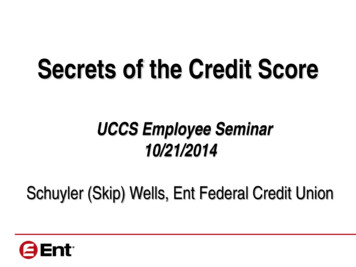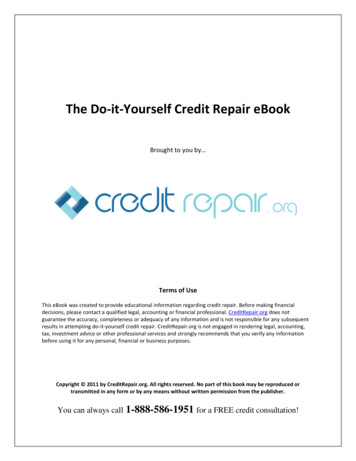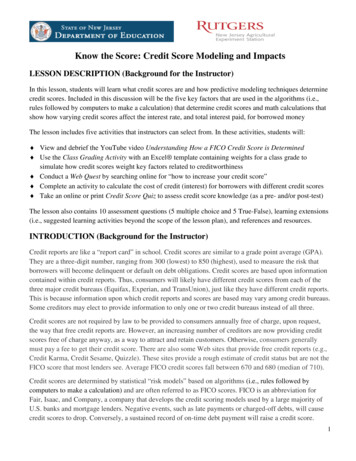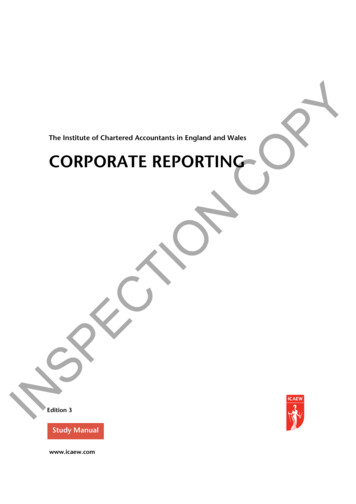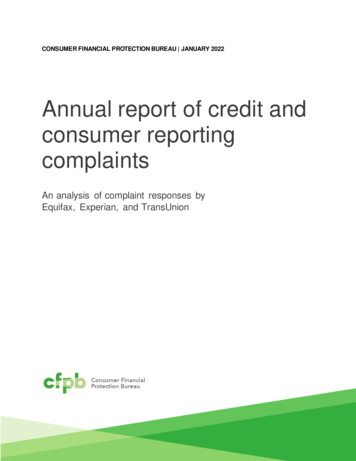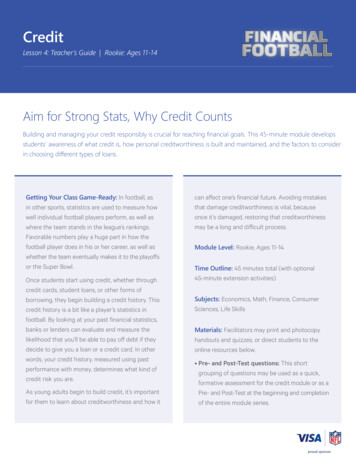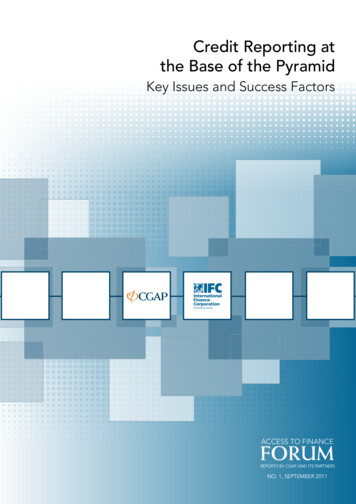
Transcription
Credit Reporting atthe Base of the PyramidKey Issues and Success FactorsAccess to FinanceForumReports by CGAP and Its PartnersNo. 1, September 2011Credit Reporting at the Base of the Pyramid: Key Issues and Success FactorsA
“An essential element in the prevention of multiple-lending and over-borrowing is the availability ofinformation to the MFI of the existing outstanding loan of a potential borrower. This is not possibleunless a Credit Information Bureau is established expeditiously.”—Malegam Committee Report, Reserve Bank of India, January 2011“Don’t wait until the problems are there before putting a credit bureau in place.”—An MFI leader in Nicaragua, autumn 2009“[Our] Central Registry of Credits is a comprehensive one: along with commercial banks, [microcreditorganizations and] all other types of credit institutions are included. And it is detailed, too, containingall relevant data on all kinds of borrowing, for both individuals and legal entities. As such—and sinceit prevents multiple, excessive indebtedness—consulting it is indispensable for making sound lendingdecisions. With the establishment of Central Registry of Credits, we have reached a higher level offinancial discipline and the level of nonperforming loans [has] significantly decreased.”—Kemal Kozarić, Governor, Central Bank of Bosnia and Herzegovina, April 2011 2011, CGAP and IFC. All rights reservedCGAP1818 H Street, N.W., MSN P3-300Washington, DC 20433 USATelephone: 1 202.473.9594Email: cgap@worldbank.orgwww.cgap.org
IntroductionOver the past five years, the microcredit sector hasexperienced unprecedented growth. The number ofborrowers served by microfinance institutions (MFIs) hasincreased threefold to reach 120 million clients, according to MIX estimates as of December 2009—and byother estimates the number may be as high 190 million(Microcredit Summit Campaign 2011). In large markets,such as Mexico and South Africa, commercial banksand consumer lending companies have expandedtheir activities to include microfinance for low-incomehouseholds.Unfortunately, the growth of microcredit is not alwayssustainable. Some iconic markets, such as India andBosnia–Herzegovina, are experiencing large-scale creditcrises, and they are not alone. The portfolio at risk (PAR)of MFIs worldwide has increased steadily over the pastthree years, according to the Symbiotics SYM50 index.This is an alarming trend for an industry that has beenheralded for its outstanding asset quality.The deterioration in the quality of MFI loan portfolios can be attributed to several factors. Some fastgrowing MFIs have outgrown their risk managementsystems and controls. These weaknesses have oftenbeen exacerbated by high staff turnover, leading to afurther erosion of credit discipline. Rapid growth hasalso been focused in narrow geographies, which in turnaffected borrower repayment incentives and behaviors.In some microfinance markets, the entrance of banksand consumer lenders hastened unhealthy competitionamong different base-of-the-pyramid lenders. The riskof over-indebtedness among borrowers rose markedlyin several countries, such as Peru and Morocco.1Hardly an article or blog has appeared in recent monthson the microcredit delinquency crisis without mentionof the critical role of effective credit reporting in averting, or at least reducing, the risk of over-indebtednessand borrower defaults. Although credit reporting alonecannot create credit discipline in a market or compensate for inadequate underwriting standards, it can helpmicrolenders better originate loans, manage credit risk,and create a powerful incentive for repayment amongborrowers. Over the past 10 years, credit reportinghas rapidly expanded in emerging markets, but manyof these initiatives have emerged in the mainstreambanking and consumer lending sectors, often leavingmicrolenders and the low-income consumers they serveoutside of this information infrastructure. Today, only ahandful of countries have well functioning and inclusivecredit reporting systems that include the range of bankand nonbank lenders that serve the poor.This report takes a fresh look at the state of creditreporting at the base of the pyramid. The data andanalysis for this paper are drawn from IFC and CGAPmarket intelligence on credit reporting systems. In Part1. Over-indebtedness refers to the risk faced by credit customers of taking on levels of debt that may be greater than they can manage, or that causeundue sacrifices to repay. This can result from a range of causes, including personal errors in estimating levels of manageable debt (by consumers and/or lenders), changes in household income, or unforeseen events that have significant economic impact, such as medical emergencies or natural disasters.Over-indebtedness is a growing risk in many microfinance markets, but remains challenging to define, as it includes the subjective, and highly personalized,question of “how much credit is too much?” However, Schicks and Rosenberg (2011) identify six concepts being used as definitions, or proxies, for over-indebtedness: negative impact, default and arrears (late payments), debt ratios, multiple borrowing, borrower struggle and sacrifice, and composite indicators.1
I, we present the microlending market, the diversity ofplayers, and their evolving demand for credit information. In Part II, we describe three main approachesfor credit reporting at the base of the pyramid: creditbureaus, credit registries, and MFI-specific systems forexchanging client information. Each of these approaches is illustrated by country examples. Part III examinesthe lessons learned for effective credit reporting at thebase of the pyramid and identifies key success factors aswell as common challenges. Part IV presents a summaryof recommendations for policy makers, microlenders,donors, and others interested in encouraging creditreporting at the base of the pyramid.Box 1. Key Messages on Credit Reportingat the Base of the Pyramid MFIs still dominate the base-of-the-pyramidlending landscape in many markets. However, inincreasing numbers, other types of lenders—including commercial banks, consumer lenders,and retailers and other nonfinancial firms—arealso now targeting these market segments.For credit reporting to be effective as a tool inaverting over-indebtedness at the base of thepyramid, all relevant lenders in a given marketneed to participate. Country-level factors determine which approaches to credit reporting at the base of thepyramid will have the best prospects for success—credit bureaus, credit registries, MFIspecific client databases, or some hybrid ofthese. The various approaches to credit reporting are not mutually exclusive: two or evenseveral approaches can very well coexist andoverlap in the same country. Credit reporting systems, like credit markets, aredynamic, and they can be expected to evolveover time in response to market and regulatorychanges and to better respond to lender andconsumer demands for improved services. No one approach carries a guarantee of successin any market, and each has its predictable orlikely limitations, especially those influencingwhich types of lenders can, and have the incentive to, participate. There are challenges to effective base-of-thepyramid credit reporting, some of the mostimportant being (i) establishment of creditreporting systems that cover all types of baseof-the-pyramid lenders in a given market; (ii)regulatory or cost barriers that limit participation;2(iii) comparatively high costs of obtainingand processing high-quality data on base-ofthe-pyramid borrowers; (iv) establishing theidentity of base-of-the-pyramid borrowers;and (v) protection of data privacy and accuracyat a reasonable cost given high transactionvolume and low loan sizes. But growing globalexperience also shows likely success factors inaddressing the challenges. Policy makers, donors, and lenders servingthose at the base of the pyramid all have rolesto play in developing credit reporting systemsthat gather reasonably thorough and accuratedata on base-of-the-pyramid borrowers andcover the full range of formal lenders from whichthese clients are borrowing. Policy makers canremove regulatory barriers to participationand fashion incentives—or even mandates,if removing the barriers proves insufficient toget reasonable market coverage. Donors havethe means to support policy makers, creditreporting service providers, and base-of-thepyramid lenders to understand the benefits ofcomprehensive credit reporting systems and toovercome obstacles—and they have the meansto inform base-of-the-pyramid borrowers whythis is in their best interest. Base-of-the-pyramidlenders have the most important role to play:by supplying data and purchasing credit reportsthey provide the building blocks of creditreporting systems with the potential to fosterresponsible lending at the base of the pyramidand avert irresponsible lending that leads toover-indebtedness.Credit Reporting at the Base of the Pyramid: Key Issues and Success Factors
Part I. Lending at the Base of thePyramid and Demand for CreditReportingCredible estimates of the number of microborrowers fromMFIs range between 120 million and 190 million worldwide.2 But, an estimated 2.7 billion adults worldwide donot have a savings or credit account in their name with abank or other formal institution (CGAP and World Bank2010). Most of these “unbanked” people are poor, manyare informally employed, and their incomes tend to beirregular. For these consumers, credit is needed to smoothconsumption and may be used to purchase consumergoods or longer term assets, such as land, animals, housing, or tools needed for work. These individuals also tendto lack physical collateral to pledge when seeking a loan.For consumers at the base of the pyramid, developing their“reputation collateral” in a credit reporting system canbe a highly valuable asset, one that facilitates credit withtheir existing lender(s) and that enables them to seek othersources of finance rather than being tied to one provider.Policy makers increasingly recognize the need for financial services at the base of the pyramid and the relationship that access to finance has with other developmentgoals in livelihoods, health, education, and gender equality, among others. The private sector has also awakenedto the market potential that these 2.7 billion consumersrepresent. New players to this market segment, including commercial banks, credit card companies, consumerfinance companies, and retailers, are offering creditproducts and other financial services to consumers withever lower income levels. These new providers do notemploy high-touch lending methodologies, but ratherthey need data to drive their lending models and creditdecisions. As lending expands to the massive market forfinancial services at the base of the pyramid, the need forreliable, accurate information on existing and potentiallow-income borrowers is also growing.Understanding the Data Needsof Different Financial ServicesProviders to the Base of thePyramidMicrolenders can be broadly classified into four types:informal lenders; specialized financial services providers,such as MFIs; commercial banks and consumer lenders;and suppliers of goods and services, such as retailers(pharmacies, grocery stores, etc.) or, in rural areas, firmsproviding agricultural inputs. Within each of these provider types, different lending methodologies may be used.Nonetheless, these microlenders tend to share somesimilar operational elements, including the extent of theirdemand for, and use of, credit reporting information.Informal lenders. Informal financial services providers,such as moneylenders, as well as semi-formal lenders,such as village banks in Africa or self-help groups inIndia, are an important source of microcredit for lowincome families in many markets. This is especially thecase in sub-Saharan Africa.3 Informal lenders are part of2. See Microcredit Summit Campaign (2011) and Symbiotics SYM50 index. Cf. Wyman (2008), which estimates 180 million borrowers worldwide from all typesof lenders, specifically for microenterprise purposes.3. A recent Finscope survey in Tanzania shows that 16.5 percent of the adult population in Tanzania borrows from informal lenders compared to only 1.5percent from formal financial institutions. Informal microlenders are characterized by relatively high interest rates and lack of reliability (Armendariz de Aghionand Morduch 2005).Credit Reporting at the Base of the Pyramid: Key Issues and Success Factors3
the community and, generally, have a good knowledgeof their clients. They do not use formal credit reportinginformation, but rather, they gather intelligence on theirclients’ credit history through their social networks andpersonal relationships with borrowers. Because data onthese informal lenders can never be captured adequately, market coverage of any base-of-the-pyramid creditreporting service provider never provides the full pictureof lending activity in a particular country.Microfinance institutions. MFIs are financial providersthat specialize in serving low-income market segments.They can be regulated financial institutions (such asbanks or regulated finance companies), although thelargest numbers of MFIs in most markets take otherlegal forms, such as financial cooperatives and nongovernmental organizations (NGOs). MFIs have becomea major source of microcredit for the poor. The 1,929MFIs reporting to MIX are active in 111 countries andserve 91.7 million microcredit borrowers. Over time,many MFIs have developed original and robust lendingmethods, which often involve strong loan officer–clientrelationships, a good knowledge of customers’ reputation and business that is supported by frequent visits tothe business, and nontraditional guarantee forms, suchas mutual group guarantees.Until the past few years, many MFIs demonstratedexcellent asset quality, with the sector average fornonperforming loans, defined as portfolio at risk (PAR)over 30 days, being consistently below 4 percent.4In this context, most MFI managers feel they can dobusiness without solid credit reporting and only in afew, more advanced and competitive markets, such asPeru, Bolivia, and Ecuador, have MFIs been incorporating credit reports into their underwriting processes.However, credit risk is now seen as one of the majorrisks facing the MFI industry, according to Lascelles andMendelson (2011). In this context, many policy advisersand industry experts, as well as MFI managers, havebeen calling for existing or new credit reporting systemsto be integrated into the microfinance sector.Banks and consumer lenders. Banks and consumerlenders are moving down market with new offerings forlow-income families. These include institutions such asBanque Centrale Populaire in Morocco, which is providingconsumer loans as well as other financial products (savings and insurance) to poor families. These formal sector lenders prefer to lend to low-income borrowers withregular incomes, such as salaries or government benefits.They tend to rely on credit scoring methods and are keento incorporate credit information into their underwritingprocesses when such data exist. But the experience ofconsumer lenders in microlending has not always beensuccessful. In the 1990s, in Bolivia, consumer lenders offered loans about the same size as microenterprise loans,quickly and flexibly, to salaried workers. While, in theory,the market for consumer lending is distinct from themicrocredit market—salaried employees versus informalenterprises—in practice, consumer lenders often competedirectly with other microlenders, including MFIs. Whenthe Bolivian microlending market expanded unsustainablywith the entrance of consumer lenders, one of the mainpolicy responses of the government was to enhance creditreporting at the base of the pyramid.Retailers and other nonfinancial credit providers.Retailers and other types of firms that provide creditor services in advance of payment (such as utilities,schools, or sellers of agricultural inputs) may also usearms-length lending methodologies that require accessto credit data. While smaller retailers are likely to basedecisions on informal relationships with their borrowers—more akin to the informal sector lenders discussedearlier—larger retailers require credit data for their riskmanagement and lending technology. Since many lowincome consumers first have access to retail credit or topost-paid utilities before they have access to loans fromformal financial institutions, including these providers incredit reporting systems can be helpful in establishingcredit histories for the unbanked. It is also useful to notethat, in some markets, including several in Latin America(such as Peru, Uruguay, and Chile), retailers have a longhistory of collecting and sharing payment data on bothindividuals and firms.4. See MIX, 2006–08 MFI Trend Lines Benchmarks covering 1,019 MFIs worldwide.4Credit Reporting at the Base of the Pyramid: Key Issues and Success Factors
Part II. Some DifferentApproaches to Credit Reportingat the Base of the PyramidAround the world, three broad approaches to covering base-of-the-pyramid borrowers in credit reportingsystems have been tried, often in combination (and withalmost as many country-specific variations as there arecountries attempting this). (See Box 2.) Credit bureaushave sought to expand their database to include payment data on low-income individuals (and to expandtheir customer base to include lenders such as MFIstargeting these individuals as borrowers). Less commonly, credit registries have incorporated nonbankmicrolenders (most typically in countries where theyhave been brought under the regulatory jurisdiction ofthe banking authority).5 Finally, MFI-specific client databases have been created, often because of obstaclesto expanding existing credit bureaus or credit registriesto include either or both low-income customers andnonbank lenders targeting them.6However, these three basic approaches do not make upa simple menu from which policy makers or industryparticipants choose. Many factors influence the way inwhich credit reporting develops in a country, includingthe structure of its retail credit markets (and in particular, the concentration of assets in a few institutions andthe degree of overlap in different categories of lendersthat target or might target base-of-the-pyramid borrowers) and the financial system regulatory framework(especially the extent to which nonbank lenders areclearly regulated). Donor agency policy and domesticpolitical economy also play a role in determining whichapproaches are tried, what challenges they face, andwhich have the best chances of success.It is also important to understand that the three approaches to credit reporting described are not mutuallyexclusive: two or even all three approaches can verywell coexist and overlap in the same country; hybridapproaches may also exist. And, as credit reportingsystems, like credit markets, are dynamic, they can beexpected to evolve over time in response to market andregulatory changes and to better respond to client demands for improved services. Finally, none of the threemodels carries a guarantee of success in any market,and each has its predictable or likely limitations.7Credit bureaus. Credit bureaus collect information on aborrower’s credit history from various sources, includingfinancial institutions, nonbank lenders, telecommunications companies, courts, and other available sources.The information is then merged and analyzed to form acomprehensive credit history record for each borrowerand is sold to lenders in the form of credit reports. Mostcredit bureaus are privately operated, for-profit entitiesand can be found in more than 100 countries worldwide.Credit bureaus generally hold a broad range of datathat often includes both positive (on time) and negative(delinquent) payment information. Of course, the quality and scope of credit bureaus varies, within countries5. Credit bureaus and credit registries are different types of credit reporting service providers. Service providers can be either private entities or public sectorentities. Credit bureaus represent a model of credit information exchange the primary objective of which is to improve the quality and availability of data forcreditors to make better informed decisions. Credit registries represent a model of credit information exchange the main objectives of which are to assistbank supervision and enable data access to regulated financial institutions to improve the quality of their credit portfolios. For more information, see WorldBank (2011).6. In this report, we use the term “credit reporting service providers,” “credit reporting mechanisms,” or simply “credit reporting” when referring genericallyto credit bureaus, credit registries, or MFI-specific databases to avoid repeating the three general approaches described in this section.7. The numerous challenges to building well-functioning credit reporting systems at the base of the pyramid are discussed in Part III.Credit Reporting at the Base of the Pyramid: Key Issues and Success Factors5
Box 2. EcuadorBox 3. Bosnia–HerzegovinaThe Ecuadoran rural finance network, RFR, lookedat alternative approaches to credit reporting andsettled on a partnership with one of the privatelyoperated credit bureaus in the country, Credit Report. It selected the firm because of the strengthof its technology platform, financial soundness,ownership by the international credit reporting firm Equifax (representing experience), andthe price per report that the bureau guaranteedfor RFR members. At the time the deal with RFRwas struck, there were six privately owned creditbureaus operating in Ecuador. In 2011, after yearsof intense competition and bare bones pricing—reports cost less than 0.10 each—only CreditReport is left. The unique access it had to dataon borrowers at the base of the pyramid throughRFR’s members was one of the key factors thatcontributed to its success, as it had superior market coverage compared with its competitors. ForRFR and the MFIs it serves, working with a privatelyowned credit bureau provided access to data fromother parts of the credit market; access to relatedtools, such as credit scoring; and access to qualitydata—all at a very attractive price.In Bosnia–Herzegovina, the privately owned andoperated credit bureau LRC was established in2000, but this did not protect the credit marketfrom an over-indebtedness crisis in 2009. Thecrisis may have stemmed in part from the factthat participating in LRC is voluntary, resulting inincomplete credit reporting coverage. To address the issue of over-indebtedness, the CentralBank Governing Board expanded the scope ofits Central Registry of Credits (abbreviated in thelocal language as “CRK”). Regulated financial institutions—all formal lenders, including banks andMFIs—are required to join CRK. While LRC offersa broader range of services, it is also more expensive to use and still does not have comprehensivemarket coverage. CRK services, on the other hand,are more affordable, and most importantly CRKcovers the whole lending market.and across nations. However, it is generally true thatcredit bureaus contain data from the widest range ofsources, including nonbank and nonfinancial sources,such as utility payments, that are more likely to coverpoor people who have not previously borrowed froma formal lender (see Box 3). In addition to providingcredit reports, credit bureaus differentiate themselvesfrom other types of credit reporting service providers byproviding a wide range of value-added services. Thesetypically include credit scores that provide a rank-ordernumber or “score” to indicate the relative creditworthiness (or alternatively, risk) of customers, as well as otherservices, such as identity verification, debt collection,fraud monitoring, and so forth. There are numerousexamples of credit bureaus affirmatively reaching out toMFIs and other lenders to base-of-the-pyramid borrowers, both as suppliers of data and purchasers of creditreports and scores. However, there are also examplesof credit bureaus owned and dominated by banks andother mainstream financial institutions that are essentially closed to participation by MFIs and similar lenders.Credit registries. Credit registries are typically ownedand operated by a central bank or other financialsupervisors. In most countries, credit registries collectcredit information from prudentially regulated financial6institutions, which may exclude many, if not all, microlending institutions (unless they are licensed as banks).However, in an increasing number of countries, a rangeof MFIs is coming under formal oversight by bankingauthorities (even if nondepository lenders are, appropriately, exempted from full-blown prudential regulation),with the result that MFIs have the option—or more typically are compelled—to report to a credit registry (seeBox 4). The primary objective of most credit registries isto support banking supervision and to provide data toregulated financial institutions to enable them to better manage credit risk and improve the quality of theircredit portfolios.MFI-specific client databases. A third approach tocredit reporting for microlenders typically grows out ofthe self-identified microfinance sector (see Box 5). Incountries around the world, MFIs, regardless of theirlegal type, have begun sharing credit history data aboutcustomers on their own—initially often very informally,such as sharing Excel spreadsheets of “blacklists” ofdelinquent customers. These schemes have serious limitations (including, typically, on the legal side), but theycan be established relatively quickly and offer valuableinformation on MFIs’ shared customers and delinquentclients. Some donors, conscious of the barriers thesetypes of lenders may face in participating meaningfully in either credit bureaus or credit registries, havepromoted MFI-specific client databases. Over time, in anumber of important markets, such MFI-specific clientdatabases have evolved into privately owned and operated credit bureaus (or a hybrid thereof).Credit Reporting at the Base of the Pyramid: Key Issues and Success Factors
Box 4. NicaraguaIn Nicaragua, in 2002, MFIs began sharing information through Sin Riesgos, a credit bureau promoted by the Nicaraguan microfinance association,ASOMIF. At the time it was created, Sin Riesgoswas the only privately held credit bureau operatingin the country. Commercial banks were unable toshare credit data except via the public credit registry due to the legal framework in place regardingbank secrecy. By 2004, the law on bank secrecy hadbeen changed to allow credit information sharing,and a credit bureau with foreign investment by amajor international credit bureau had entered themarket. Today, the microlending market in Nicaraguais served by both Sin Riesgos and by the international bureau TransUnion. Over time Sin Riesgoshas reached out to lenders beyond the MFI sector,including retailers and commercial banks. Similarly,TransUnion has made in-roads into the microfinancesector, especially after the recent crisis and “no pay”movement.Box 5. Credit Reporting WorldwideThe World Bank’s annual survey, Doing Business, measures business regulations for local firms in 183 economiesand selected cities at the subnational level. The Getting Credit Indicator from Doing Business covers the following:a Depth of credit information index. Measures rules and practices affecting the coverage, scope, and accessibility of credit information available through either a public credit registry or a private credit bureau. Public registry coverage. Reports the number of individuals and firms listed in a public credit registry withinformation on their borrowing history from the past five years. Private bureau coverage. Reports the number of individuals and firms listed by a private credit bureau withinformation on their borrowing history from the past five years.Comparative Regional Presence of Credit Reporting, 2010Depth of creditinformation index(0–6, 6 Best Score)Public registrycoverage(% of adults)Private bureaucoverage(% of adults)East Asia and Pacific2.18.217.3Eastern Europe and Central Asia4.013.121.3Latin America and the Caribbean3.310.131.5Middle East and North Africa3.35.37.0OECD4.78.061.0South Asia2.10.83.8Sub-Saharan Africa1.72.74.9a. Available at www.doingbusiness.org. The Getting Credit Indicator also measures the legal rights of borrowers and lenders with respect to securedtransactions.Credit Reporting at the Base of the Pyramid: Key Issues and Success Factors7
Part III. Challenges and SuccessFactors in Credit Reporting atthe Base of the PyramidThe challenges to effective credit reporting at the base ofthe pyramid—and the factors that influence the successof credit reporting systems as a means of averting or mitigating over-indebtedness among base-of-the-pyramidborrowers—can be roughly grouped into four categories:1. Market-level issues, which affect all lenders targetingthis market regardless of their type.2. Lender-level issues, which vary according to thecharacteristics of the type of lender in question,particularly its regulatory status.3. Credit reporting service provider-level issues, whichrelate to providing quality and sustainable creditreporting services to microlenders.4. Borrower-level issues, which relate most directlyto the base-of-the-pyramid borrowers who are thesubjects of credit reporting.These groupings of challenges and possible successfactors are closely interrelated and often overlap. Achallenge or success factor at one level is likely to havecorollaries at the other levels as well.Market-Level IssuesAmong the market-level issues affecting base-of-thepyramid credit reporting, three concerns tend to figureas the most important: (i) the extent to which availablecredit reportin
base of the pyramid and identifies key success factors as well as common challenges. Part iV presents a summary of recommendations for policy makers, microlenders, donors, and others interested in encouraging credit reporting at the base of the pyramid. Box 1. Key Messages on Credit Reporting at the Base of the Pyramid


